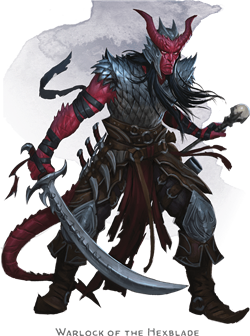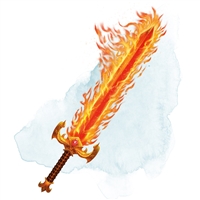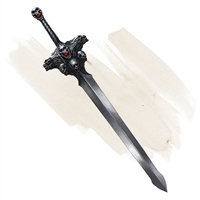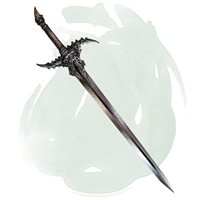 An ancient power lurks within magical blades across the cosmos and seeks to find purchase in the shadows of your soul. Its inscrutable intelligence subtly guides your actions in ways that you could never comprehend. Your patron exists beyond the borders of this reality in a vague and amorphous form, but it manifests its power through the edge of a blade. Perhaps many blades throughout the world answer to its irresistible call. Only your adventures will reveal the extent of your mysterious patron’s power.
An ancient power lurks within magical blades across the cosmos and seeks to find purchase in the shadows of your soul. Its inscrutable intelligence subtly guides your actions in ways that you could never comprehend. Your patron exists beyond the borders of this reality in a vague and amorphous form, but it manifests its power through the edge of a blade. Perhaps many blades throughout the world answer to its irresistible call. Only your adventures will reveal the extent of your mysterious patron’s power.
The Hexblade warlock patron transforms the warlock from an atypical spellcasting class into a formidable front-line warrior. A warlock who forms a pact with the Hexblade might be obsessed with learning the identity of their patron, or perhaps they embark upon a quest to find one of their patron’s personal blades, like the legendary artifact Blackrazor.
Emulating Hexblades from Fiction
The most prominent Hexblade warlock in the popular D&D consciousness is Fjord (Travis Willingham) from Critical Role. As far as we currently know, Fjord’s story defies the explicit text of the Hexblade as described in Xanathar’s Guide to Everything in favor of a more personalized story, but this is to be expected from Matthew Mercer and his world of Exandria—in which everything is familiar, but just different enough to keep people guessing. Fjord does, however, face a quest that involves learning the identity of his patron and understanding its massive and presumed-boundless power.
One thing that’s clear in Critical Role is that Travis is being surprised at every turn by the story Matthew is weaving for his character. This is a great option if you want to unravel a mysterious story surrounding your patron… but it only works if you have a DM who is a consummate storyteller like Matthew Mercer, and is willing to put in all the time and effort it takes to create a storyline like that.
Be nice to your Dungeon Masters, folks.
Of course, another option is for you to come up with a story for your patron and hand it to your DM, and then say “go wild with it.” You’ve just made life easier for your long-suffering DM, and you suddenly have a say in the lore of the world. If you’re willing to put in the work to do this, I promise you that 19 out of 20 DMs will love you for coming up with free lore for them.
The classic hexblade-like character from fiction, however, is Elric of Melniboné, created by Michael Moorcock. The tales of Elric were a major inspiration for the pulp fantasy-loving Gary Gygax when he created Dungeons and Dragons with Dave Arneson in the early ‘70s. Elric, a sickly and drug-dependent emperor, discovers the arcane blade Stormbringer, which is actually an ancient demon that has taken the form of an ebon-bladed and rune-etched sword. The legendary blade Blackrazor, first appearing in the D&D adventure White Plume Mountain, is so closely inspired by Stormbringer that the resemblance may transcend inspiration. But that’s neither here nor there. As it stands, Elric drew great power from Stormbringer—allowing him to become a great warrior and spellcaster, free from his dependency on life-saving drugs, but it came at a great cost. Stormbringer needed to consume the souls of the living, and Elric needed Stormbringer.
There was only one option. Though Elric despised the accursed blade, he is compelled—sometimes literally compelled by Stormbringer’s magic—to satiate his “patron’s” dark hunger.
If that’s not a Hexblade, I don’t know what is. Some of the requisite traits for a Hexblade are: possessing a powerful, sentient sword (or having a relationship with a dark power that manifests through a sword), possessing some sort of magical power, and facing a great moral choice—perhaps temptation towards power-hungry cruelty. Not every Hexblade warlock checks all these boxes, but they're all good starting points. Other examples of hexblades in pop culture include Sadlygrove ("Tristepin") and his sentient blade Rubilax from the French animated series Wakfu, and Siegfried Schtauffen and the demon sword Soul Edge—and thus, Siegfried's blade-possessed alter ego Nightmare—from the Soul Calibur arcade game series. What other characters fit this bill?
Playing a Hexblade Warlock
The Hexblade patron was introduced in Xanathar’s Guide to Everything, and accompanying it were a slew of eldritch invocations that improve your ability to fight in close combat. The simple fact of the matter is, making a pact with the Hexblade is your best option if you want to be a front-line damage dealer. It turns you into something akin to an eldritch paladin. That’s not to discount other options; Astrid Sunglow is a character in my current campaign, and she is a Celestial warlock who has made a Pact of the Blade, allowing her to split her focus between raw damage and healing. Astrid feels very much like a character right from Sailor Moon, being able to both punish evil and protect her friends.
 If pure damage and personal survivability is all you want, though, there’s no better choice of patron for a Pact of the Blade warlock than a Hexblade. Pairing your Hexblade patron with other pacts (Pact of the Tome or Pact of the Chain) is an interesting and valid option. Pact of the Tome is more valuable than Pact of the Chain when paired with the Hexblade, because many of your class features trigger off of your own attacks—and not just weapon attacks; your spell attacks count too, so eldritch blast to your heart’s content! Regrettably, attacks made by the familiar you gained through the Pact of the Chain do not count as your own attacks.
If pure damage and personal survivability is all you want, though, there’s no better choice of patron for a Pact of the Blade warlock than a Hexblade. Pairing your Hexblade patron with other pacts (Pact of the Tome or Pact of the Chain) is an interesting and valid option. Pact of the Tome is more valuable than Pact of the Chain when paired with the Hexblade, because many of your class features trigger off of your own attacks—and not just weapon attacks; your spell attacks count too, so eldritch blast to your heart’s content! Regrettably, attacks made by the familiar you gained through the Pact of the Chain do not count as your own attacks.
At 1st level, you gain the Hexblade’s Curse and Hex Warrior features. The latter feature is quite powerful, as it grants you a slew of proficiencies that make you a capable warrior. It also grants you the ability to make weapon attacks using your Charisma modifier instead of your Strength or Dexterity. Just like Elric gaining power through Stormbringer despite his physical frailty, so too does your magical blade grant you supernatural battle prowess.
Your Hexblade’s Curse is similar in applicability to a warlock’s hex or a ranger’s hunter’s mark, in that it allows you to choose a single creature to suffer increased damage when you attack them. It also grants you an improved critical range against that creature and the ability to restore hit points when you damage them. It’s very powerful, but do mind its short rest recharge time.
 At 6th level, you gain the Accursed Specter feature. Once per long rest, you can ensnare the soul of a humanoid that you dealt the killing blow to, and cause it to rise as a specter under your command. It’s eerie, flavorful, and fairly powerful. Most importantly, it’s disposable. This isn’t a beloved animal companion or honorable steed you have to worry about. This is an eldritch phantom bound to your will; do with it as you see fit.
At 6th level, you gain the Accursed Specter feature. Once per long rest, you can ensnare the soul of a humanoid that you dealt the killing blow to, and cause it to rise as a specter under your command. It’s eerie, flavorful, and fairly powerful. Most importantly, it’s disposable. This isn’t a beloved animal companion or honorable steed you have to worry about. This is an eldritch phantom bound to your will; do with it as you see fit.
At 10th level, your Hexblade’s Curse improves in power when you acquire the Armor of Hexes feature. Now, when the target of your curse attacks you, you can spend a reaction to impose a flat 50% chance to miss on their attack, regardless of their attack roll. You were already powerful in single-target encounters; this makes you stronger still. Cut down boss monsters with impunity!
Finally, your 14th level feature is Master of Hexes, which grants yet more power to your Hexblade’s Curse. Now, when the target of your curse dies, you can cause the curse to instantly “jump” to another nearby creature.
Throughout your warlock career, you also gain special spells granted by your patron. This is just like every other warlock patron, but yours are particularly martial in theme, with spells like branding smite and elemental weapon making their mark on your spell list.
Playing a Hexblade Your Way
 Looking between iconic hexblades like Fjord and Elric, it’s already clear that there’s more than one way to play a warlock with a Hexblade patron. Consider the lore insinuation that the Raven Queen herself might be the true source of your Shadowfell-inspired power. Is this the route you want your story to take? Do you even care about learning the identity of your mysterious patron, so long as they continue to grant you eldritch power?
Looking between iconic hexblades like Fjord and Elric, it’s already clear that there’s more than one way to play a warlock with a Hexblade patron. Consider the lore insinuation that the Raven Queen herself might be the true source of your Shadowfell-inspired power. Is this the route you want your story to take? Do you even care about learning the identity of your mysterious patron, so long as they continue to grant you eldritch power?
Warlocks are classes with a powerful aesthetic. Feel empowered to make your hexblade dramatic, and really own your character. With so many mysteries surrounding your character, don’t squander this opportunity to really have fun with your backstory!
 James Haeck is the lead writer for D&D Beyond, the co-author of Waterdeep: Dragon Heist and the Critical Role Tal'Dorei Campaign Setting, the DM of Worlds Apart, and a freelance writer for Wizards of the Coast, the D&D Adventurers League, and Kobold Press. He lives in Seattle, Washington with his partner Hannah and his feline patrons, Mei and Marzipan. You can usually find him wasting time on Twitter at @jamesjhaeck.
James Haeck is the lead writer for D&D Beyond, the co-author of Waterdeep: Dragon Heist and the Critical Role Tal'Dorei Campaign Setting, the DM of Worlds Apart, and a freelance writer for Wizards of the Coast, the D&D Adventurers League, and Kobold Press. He lives in Seattle, Washington with his partner Hannah and his feline patrons, Mei and Marzipan. You can usually find him wasting time on Twitter at @jamesjhaeck.








-
View User Profile
-
Send Message
Posted Oct 24, 2018I think it could be fun to reflavoe the hexblade by saying the weapon is something like a holy avenger, so it's like the celestial pact except you get all the hexblade features rather than the celestial ones and you are still on a quest to slay evil. I like the mechanics of the warlock, but I enjoy reflavoring it to be less edgy and almost villainous, so I enjoyed seeing the celestial pact come out. Now, I just need a DM who is ok with me changing the flavor (or even damage type) of certain invocations that almost have to make you look evil
-
View User Profile
-
Send Message
Posted Oct 24, 2018I have a character ready to go for Dragon Heist or another story. She’s a Yuan-Ti pureblood who left the other yuan-ti because she was tired of them praying to dead and absent gods. She looks mostly human just has slitted yellow eyes. She moved to Waterdeep and started to become a player in noble circles and has the courtesan background as a result. She’s a hex blade warlock and I’m still trying to work out her patron. She’s not big on the gods due to her dealings with the fellow Yuan-ti. So maybe her Pact is with the weapon itself. I want her to use a whip because I like it thematically.
-
View User Profile
-
Send Message
Posted Oct 24, 2018I think this is the first time I’ve seen Wakfu used as a point of inspiration for building a character. Quite happy that it is too, there’s a lot of interesting concepts to run with from that show.
-
View User Profile
-
Send Message
Posted Oct 24, 2018My Hexblade is the half-elf daughter of an epic level human Archfey Bladelock and an eladrin member of the Summer Court. Her father's patron, Oberon, bound her father's soul and power to his blade when he sacrificed himself to save Oberon. Now my character has bound herself to her father's blade, soul, and power with the goal to find a way to return him to life (his death was complicated), while he guides her and watches over her as she makes him proud.
-
View User Profile
-
Send Message
Posted Oct 24, 2018I have created a character very similar to Elric, a drow hexblade warlock who is also the estranged son of Jarlaxle. Blackrazor speaks to him telepathically through his pact sword occasionally, and the only reason he isn't tempted to destroy and consume every enemy in sight is because we're playing WDH.
-
View User Profile
-
Send Message
Posted Oct 24, 2018I feel it worth bringing into attention that the hexblade patron doesn't necessarily have to be a sword. consider that pact of the blade already makes you proficient in any weapon you choose as your pact weapon, and so long as you are proficient in the weapon you posess, any weapon can in theory be your sentient patron. Axes, Polearms. I haven't gotten to play them but I've made a hexblade warlock with a greatsword that talks to her and wishes simply to travel with her, among other things.
Also, on the subject of critical role It ,may vary from table to table but it would seem that D&D Beyond doesn't restrict guns from being the subject of pact weapons or hex weapons. So consider the idea of a talking rifle
-
View User Profile
-
Send Message
Posted Oct 24, 2018My Hexblade's Patron is Eilistraee, Goddess of swordplay and dance. His main class is a College of Swords Bard, but She took an interest and dallied with him in a dream and Her touch was enough to grant him a measure of power. His eldritch blasts manifest as flung daggers made of silvery moonlight and his Booming Blade evokes the sound of Her hunting horns.
-
View User Profile
-
Send Message
Posted Oct 24, 2018Great article. Do you think you could do a warlock 101 article.
-
View User Profile
-
Send Message
Posted Oct 24, 2018I've been brewing up a Hexblade in my head for a while. Somebody who strayed upon the blade of a Sword Wraith (Mordenkainens Tome of Foes), while exploring a long forgotten battlefield. With aspirations to brcomba great warrior, he grabbed it, and the Sword Wraith appeared, not from rage, but with a clever idea. The stranger could be the hand of this Sword Wraith in the mortal world, bringing his long dead patron honor in the afterlife by doing heroic and valiant deeds. Later, the stranger would he brought back to the site to discover his Book of Shadows, his patrons skull. I'm still tinkering with the idea, but I like where I'm at so far.
-
View User Profile
-
Send Message
Posted Oct 24, 2018CoS spoiler, not a big one, but just in case I'll spoiler tag it!
I hade a player join my CoS game recently, and he wanted to play a hexblade. I saw this as a golden opportunity to connect the Sunsword to the main story in a different way. He has a strength score of 3 (Yes, he rolled all ones on one score), and has lived a frail life, haunted by shadowy demons, so when dreams of a flaming road leading to a spier with 2 walls leading out from it accompanied by a soft serene voice, promising to help him defeat his demons with his will alone if he helped deal with the voices demons first, and so he followed the flaming road and ended up in Barovia. The idea is that Sergi works in unison with his old blade to grant him the powers to defeat his brother.
I will also confess that I use his connection to the blade to give him hints (the Tarrok card readings) to give him and the group better means of defeating Strahd… This because we have hade about 6 sessions the last to years, and none of the OG players remember the readings, so I saw it as fresh chance to re-introduce them without having them to back to Madam Eve and ask for a re-reading, or any of the other ways given in the book.
Sorry, for the wall of text ;)
-
View User Profile
-
Send Message
Posted Oct 25, 2018If I ever find an Eberron game I'd like to play a Karrnathi youth who volunteered for magical experiments, coming out of it with an aberrant dragonmark which functions as his hexblade patron.
-
View User Profile
-
Send Message
Posted Oct 25, 2018Funny, I've recently made a Hexblade Warlock of my own. He's a Lawful Neutral character that's drawn by the desires of his patron, particularly since it was that patron that brought him back from death. Perhaps even more interestingly, the patron has wordlessly threatened to restore the warlock to death if their will is not done.
The motif of my warlock is the Hex Warrior bonded weapons that are a dark purple color, with pointed guards and sections of serrated blades. I got the inspiration after watching Critical Role and seeing the sea-themed motif of Fjord. It's flavor text like this that makes me very interested in the potential for warlock storytelling, Hexblades in particular.
-
View User Profile
-
Send Message
Posted Oct 25, 2018Arthas Menethil! Really, no one? :-P
-
View User Profile
-
Send Message
Posted Oct 25, 2018Emmens, it’s interesting that you mention that because in Unearthed Arcana: Modern Magic, there is an invocation that allows a warlock to make a firearm their pact weapon.
https://media.wizards.com/2015/downloads/dnd/UA_ModernMagic.pdf
-
View User Profile
-
Send Message
Posted Oct 25, 2018The flavour for Hexblade honestly feels super vague and confusing. I've had people argue it's a pact with a sentient weapon, a shadowy force that has weapons, or just a dark force in general? The fact that there's this much confusion, and the fact that the most notable Hexblade in the DND milieu at the time is one who outright doesn't use ANY of the lore presented for the Patron in favour of its own speaks volumes about the problems with the flavour and wording.
-
View User Profile
-
Send Message
Posted Oct 25, 2018Another good example of Hexblades in Fiction are every single Knight Radiant in Brandon Sanderson's Stormlight Chronicles. They even seem to mostly take Pact of the Blade. I made a version of Kaladin Stormblessed a while ago and with a bit of flavor changing of ability descriptions, I think it actually works very well. Even the ability to transform your pact weapon into different forms fits well into how Kaladin fought Szeth at the end of Words of Radiance.
-
View User Profile
-
Send Message
Posted Oct 25, 2018After my Bard bonded with a powerful sentient weapon, he took a one-level dip of Hexblade. It fit the narrative, and gave my Bard the ability to really exploit the weapon's power.
-
View User Profile
-
Send Message
Posted Oct 25, 2018I made an Aasimar Warlock, so it's a really interesting dynamic because she's trying to follow the teachings of Hieroneus, but she also has to obey her patron (a mysterious entity known as Kage no ken, "blade of shadow"). Also, her pact weapon is a nodachi made of Dragon bone.
-
View User Profile
-
Send Message
Posted Oct 25, 2018E
-
View User Profile
-
Send Message
Posted Oct 25, 2018dNate, I hadn't known that. is a very neat invocation to have, though I feel like if it were at my table I'd be so willing to simply let fire arms be covered by improved pact weapon